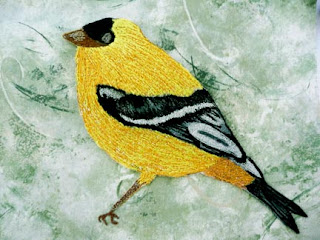Unfortunately, the gutta was too thick to
draw up into the syringe so I set about making markings onto the fabric with
the squeeze bottle applicator. What
started out as fairly thin lines became fat lines as the gutta resist “bled”
into the fabric. Any plans I had for creating
a design that made sense flew out the window and then came the scribbling. I figured that I might as well fill the space
with markings. What could hurt?
I then hung the fabric to dry. After about an hour the gutta was completely
dry. I lightly spritzed the entire square with plain water. Next I applied a 1:1 ratio of Setacolor fabric paints and water with a 2” brush.
The first color I used was yellow and then applied Oriental blue in
diagonal stripes that ultimately bled into the yellow, as I had anticipated it
would do.
 |
| Painted Fabric Over Gutta Resist Hanging to Dry |
I was initially disappointed with the image, probably because
it did not turn out as I had hoped it would.
However, as the piece dried, I began to increasingly appreciate the
randomness of the image. Now I wish that
I could be able to replicate this, although I know that will be impossible.
Here is a picture of the fabric after the gutta resist was
washed out, dried again and then ironed.
 |
| Final Fabric from Gutta Resist, with Yellow and Oriental Blue Wash of Setacolor Fabric Paints |
Revisiting the use of gutta as a resist has spawned new questions. I am now wondering if the gutta could be
applied over a stencil with a wedged make-up sponge. Unlike the lack of flow control when using a
squeeze bottle applicator, I pondering that the amount of gutta applied might
be better controlled by using a small, dense sponge. I have a few more 14” x 14” squares of cotton
fabric just waiting for further experimentation. Hmmmm.
Possibilities! Gotta love ‘em.
Always remember, never fear to experiment.
Sometimes wonderful things happen.
© Linda Friedman 2016. All rights reserved



















